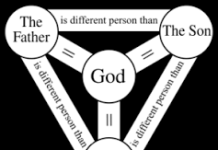Salam Laekum everyone.

A heresy is a belief that deviates from some standard, official belief. When religious authorities decide that a belief is heretical, they usually take active efforts to eradicate the belief, usually including the removal of the offending believers (by excommunication or worse). Of course, one man’s orthodoxy is another man’s heresy!
Most Christian heresies centered around the twin issues of the nature of the trinity and, more specifically, the nature of Jesus Christ. The official stand on these issues (according to all the Catholic, Orthodox, and Protestant churches) are as follows: God is a trinity, three persons but one essence; Jesus Christ was one person, simultaneously human and divine. That these two statements are not particularly rational was considered irrelevant. The trinity was seen as mysterious and a matter of faith, not reason.
What follows are eight heresies, ranging from sects that see Jesus Christ as purely divine, to others which see him as purely human.
Sabellianism: Sabellianism is named for its founder Sabellius (fl. 2nd century). It is sometimes referred to as modalistic monarchianism. The father, son, and holy ghost are three modes, roles, or faces of a single person, God. This, of course, implies that Jesus Christ was purely divine, without humanness, and therefore could not truly have suffered or died.
Docetism: The name comes from the Greek word dokesis, meaning “to seem.” Along the same lines as Sabellianism, Docetism says that Christ was not a real human being and did not have a real human body. He only seemed to be human to us. In a nutshell…
Christ only (no Jesus)
This heresy taught Jesus only appeared to have a body and was not truly incarnate. Docetists viewed matter as inherently evil, and therefore rejected the idea God could actually appear in bodily form. By denying Jesus truly had a body, they also denied He suffered on the cross and rose from the dead.
Leader(s) in the Heresy: Attributed to Gnostics and promoted by the Gospel of Peter
Corrector(s) of the Heresy: Ignatius of Antioch, Irenaeus, and Hippolytus refuted it was condemned at the Council of Chalcedon in 451AD
Monophysitism: Monophysite comes from the Greek words for “one body.” This heresy says that Jesus Christ was a joining of the eternal Logos with the human person Jesus, which occured at incarnation. He therefore is two separate natures joined in one body. Monophysitism is very much alive in several present-day Egyptian and Middle Eastern sects of Christianity.
Jesus
> Jesus Christ
Christ
Adoptionism: Adoptionism says that Jesus was a human being who was “adopted” by God at his conception, at which point he developed a divine nature. Later versions sometimes suggest that he was adopted later, such as when he was baptized by John the Baptist.This heresy denies the pre-existence of Christ and therefore denies His Deity. It taught Jesus was simply a man who was tested by God and after passing the test was given supernatural powers and adopted as a son (this occurred at His baptism). Jesus was then rewarded for all He did (and for His perfect character) with His own resurrection and adoption into the Godhead.
Leader(s) in the Heresy: Theodotus of Byzantium
Corrector(s) of the Heresy: Pope Victor (190-198AD)
Jesus > Christ
Nestorianism: Supposedly, Nestorius, Patriarch of Antioch (fl. 410), believed that Jesus Christ had two natures — man and God — which remained separate throughout his period on earth. This is not really what Nestor said (although he did deny virgin birth) but the name stuck. You can still find a few Nestorian churches in Iran.
Jesus……
Christ……
This heresy taught Mary only gave birth to Jesus’ human nature. The founder of the heresy, Nestorius, did not even want Mary to be called “Mother of God” but instead wanted her to be called “Mother of Christ”. In essence, the heresy maintained Jesus was really two separate persons, and only the human Jesus was in Mary’s womb. If that was true, then Jesus was not God incarnate while in the womb.
Leader(s) in the Heresy: Nestorius of Antioch (Bishop of Constantinople in 428AD)
Corrector(s) of the Heresy: The Council of Ephesus in 431AD
Apollinarianism: Named for Apollinaris of Laodicea (fl. 350), this heresy says that Jesus Christ was not a real man, but not totally divine either. Apollinarians suggested that he had a human body and a human soul, but his mind was taken over by the eternal Logos.
Je(Christ)sus.
This heresy denied the true and complete humanity of Jesus, because it taught He did not have a human mind, but instead had a mind that was completely Divine. The heresy lessened the human nature of Jesus in order to reconcile the manner in which Jesus could be both God and man at the same time.
Leader(s) in the Heresy: Appollinaris the Younger (bishop of Laodicea in Syria), 360AD
Corrector(s) of the Heresy: The Council of Constantinople in 381AD
Arianism: Arianism is named after Arius (c. 250 – c. 336), a priest in Alexandria. This is considered the most serious heresy. Jesus Christ was thought of as a special creation by God for man’s salvation. Arianism was the form of Christianity that the Goths adhered to, and it was popular in all the areas they conquered, including Italy, Spain, and Africa.
This heresy taught Jesus was a “creature” who was “begotten” of the Father. Only God the Father is “un-begotten”. In this view, only the Father is truly God; He was too pure and perfect to appear here on earth, so He created the Son as His first creation. The Son then created the universe. God then adopted Jesus as a son (because, after all Jesus and God are not supposed to have the same nature in this view). Jesus was worshipped only because of His preeminence as the first creation.
Leader(s) in the Heresy: Arius of Alexandria Egypt (250-336AD)
Corrector(s) of the Heresy: The Council of Nicaea in 325AD. The Nicene Creed was written to respond to this heresy.
Socianism: A version of Arianism called Socianism (from the Latin socius, meaning “companion), simply says that Jesus was an extraordinary man. This heresy still lives on in two very different forms, the Unitarians and the Jehova’s Witnesses.
Jesus only (no Christ)
Other Heresies
Not all heresies focussed on the issues of the trinity and Christ’s nature. Here are the leading examples.
Donatism: Named for its leader, the theologian Donatus the Great (d. 355), Donatism included a group of extremist sects, mostly in North Africa, that emphasized asceticism. They valued martyrdom, found lapses of faith (even under torture or threat of death) inexcusable, and believed that the sacraments required a pure priest to be effective.
See Also: https://knowislam.com.ng/2017/06/12/2433/
Pelagianism: Another group of sects, centered in Gaul, Britain, and Ireland, is associated with the Irish monk Pelagius (fl. 410). He believed that original sin was not transmitted from Adam and Eve to their children (and thereby to us). Baptism was not considered necessary, and people could be “saved” by their own efforts, that is, they did not necessarily require the grace of God. Many modern liberal Christians agee with Pelagius.
Gnosticism: Discussed in my article on Roman philosophy and religion, the Christian versions were, obviously, considered serious heresies. Gnosticism has never entirely disappeared, and can be seen in the traditions of Alchemy and Astrology, and even in modern times in the works of Carl Jung.
Manicheanism: Also discussed in that article, Manicheanism is actually a separate religion which blends Christianity with Gnosticism, Mithraism, neo-Platonism, and even Buddhism. Again, it was considered a very serious heresy. It survived well into the Middle Ages, where it strongly influenced the Bogomils in the Balkans and the Cathars in southern France.
The Bulgarian Heresy: This heresy is worth a few extra paragraphs!
In the 10th century, there arose in Bulgaria a gnostic heresy credited to a priest by the name of Bogomil. The beliefs of the Bogomils, as they were called, were adoptionist, meaning that they considered Jesus to have been “adopted” by God at the time of his baptism, but did not consider him to be a part of a trinity. Neither did they consider Mary in any way the mother of God.
See Also: https://knowislam.com.ng/2017/06/12/gaddafis-prophecy-on-qatars-diplomatic-crisis/
Simplicity and strict adherence characterized their practices, with priests elected from their own groups and congregations meeting at homes rather than churches. Infant baptism was not practiced, marriage was not considered a sacrament, and saints were considered false idols.
The heresy had a strong Manichean flavor to it. They believed that God had two sons, Michael and Satan. Satan created the material world and attempted to create Adam, but was unable to create a soul. God added the soul to Adam, but mankind was bound in service to Satan. Michael came to earth in the form of the holy spirit, which entered into Jesus. As Christ, he broke the original agreement which bound mankind to Satan. But it was Satan who orchestrated the crucifixion, and he is still working to recapture mankind by means of the mainstream churches.
The basic ideas of this Bulgarian heresy spread rapidly west, through northern Italy to Southern France. There, the believers called themselves Cathars, from the Greek word meaning pure. Others called them Albigensians, after the town of Albi, or Bougres, for Bulgarians. This last name is the source of the word bugger, due to accusations of sodomy.
Even stricter than the Bogomils, the Cathars attempted to live simple, exemplary lives, with the most serious believers refraining from sex and other physical pleasures. Many adopted strict veganism. They had only one sacrament, the consolamentum, which was something of a last rites in which sin was removed.
The Cathars believed that the God of the old testament was actually Satan, and that he was responsible for the creation of the material world. Jesus was therefore purely spirit (Docetism), since he would have been tainted if he had had a real body. By purity of living, anyone could cast off the physical body and awaken in heaven. The impure were doomed to rebirth into this physical world. One interesting side effect of this belief was that women were treated as equal to men, since we have all been men or women at some time in our past lives.
The Bogomils and the Cathars were harshly persecuted by the Orthodox church in the east and the Catholic church in the west. By the 14th century, the Bulgarians were absorbed by the Islamic Ottoman Empire, and the Cathars were virtually eliminated by Crusades and the Inquisition. They had laid the foundations, however, for the Reformation.
In our world today, if we bring out 10christians, we will find out that it would be hard to see one agree completely to what the other believes. Don’t be surprised as this article has shown that for centuries, Christians have been confused on whom Jesus truly is which is a failure from the part of the Holy Spirit whom they call the Spirit of Truth.
John 16:13King James Version (KJV)
13 Howbeit when he, the Spirit of truth, is come, he will guide you into all truth: for he shall not speak of himself; but whatsoever he shall hear, that shall he speak: and he will shew you things to come.
However, we Muslims are not surprised.
Allah SWT said
وَلَقَدۡ اَخَذَ اللّٰهُ مِيۡثَاقَ بَنِىۡۤ اِسۡرآءِيۡلَۚ وَبَعَثۡنَا مِنۡهُمُ اثۡنَىۡ عَشَرَ نَقِيۡبًا ؕ وَقَالَ اللّٰهُ اِنِّىۡ مَعَكُمۡؕ لَـئِنۡ اَقَمۡتُمُ الصَّلٰوةَ وَاٰتَيۡتُمُ الزَّكٰوةَ وَاٰمَنۡتُمۡ بِرُسُلِىۡ وَعَزَّرۡتُمُوۡهُمۡ وَاَقۡرَضۡتُمُ اللّٰهَ قَرۡضًا حَسَنًا لَّاُكَفِّرَنَّ عَنۡكُمۡ سَيِّاٰتِكُمۡ وَلَاُدۡخِلَـنَّكُمۡ جَنّٰتٍ تَجۡرِىۡ مِنۡ تَحۡتِهَا الۡاَنۡهٰرُۚ فَمَنۡ كَفَرَ بَعۡدَ ذٰ لِكَ مِنۡكُمۡ فَقَدۡ ضَلَّ سَوَآءَ السَّبِيۡلِ
Quran 5:14
SAHIH INTERNATIONAL
And from those who say, “We are Christians” We took their covenant; but they forgot a portion of that of which they were reminded. So We caused among them animosity and hatred until the Day of Resurrection. And Allah is going to inform them about what they used to do.
Funsho Animashaun @ knowislam.com.ng






